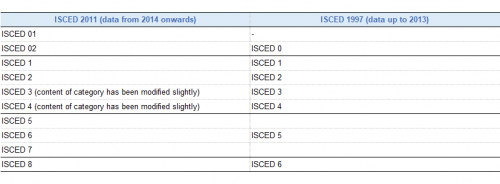City statistics – education and training
Planned article update: October 2024
Highlights
This chapter of the City statistics manual provides the definitions that should be used for compiling data at city and functional urban area level in the following sub-domains: Participation in education and training (pupils and students enrolled), and educational attainment level. In order to ensure comparability across countries, the recommended concepts and definitions are in line with the existing EU Regulations. Concepts and definitions regarding discontinued variables are not included in the chapter. The chapter also contains links to methodology, publications and external information.
Full article
Participation in education and training
Pupils and students enrolled
Day care institutions: Include all the institutions, public or private, which look after children during the day (for example: pre-school, kindergarten, nursery school or equivalent) which fulfil the criteria for programmes at ISCED level 0 (early childhood education). The data should also include special schools or equivalents for children with special needs (e.g. handicapped). The data should exclude cultural/sporting/etc. activities if undertaken for leisure purposes rather than childcare purposes.
Variables:
Child minders (qualified only) should be included if they fulfil the criteria for programmes at ISCED level 0.
The number of children 0-4 in day care or school should be given as a monthly average of all children inscribed in these institutions, either part- or full-time during the day.
The preferred data source is the UNESCO-UIS/EUROSTAT/OECD (UOE) data collection. Since the UOE provides data at NUTS level 2, the reliability of aggregates such as data at city/Functional Urban Area level may be limited. If another national data source is used, this should be indicated in the metadata.
Please note: Data on students in higher education are study-place based.
Students in higher education (ISCED 2011 level 5-8 from 2014 onwards), total, male, female (TE1026V, TE1027V and TE1028V): If data is for 2020 reference year, it refers to the school/academic year 2019/2020. As some universities have more than one campus that might be situated in two or more different cities, the students must be counted exactly there where they study (data should refer to the place/premises where they study and NOT to the legal address of the university). If the exact information is not available and estimations are not possible, this should be described in the metadata file. A compromise could be to divide the total number of students in this university by the number of the cities where the campuses/departments are located. This should be described in the metadata file. An example of such a tricky case is the University of Reggio Emilia and Modena that has an impact on two cities.
Online students should not be included.
Levels of education and training
ISCED (International Standard Classification of Education) is the reference international classification for organising education programmes and related qualifications by levels. Data until 2013 are classified according to ISCED 1997 and data as from 2014 according to ISCED 2011.
ISCED 2011:
ISCED 0: Early childhood education (‘less than primary’ for educational attainment)
ISCED 1: Primary education
ISCED 2: Lower secondary education
ISCED 3: Upper secondary education
ISCED 4: Post-secondary non-tertiary education
ISCED 5: Short-cycle tertiary education
ISCED 6: Bachelor’s or equivalent level
ISCED 7: Master’s or equivalent level
ISCED 8: Doctoral or equivalent level
Correspondence between ISCED 2011 and ISCED 1997 levels (at 1 digit)
Data on education are presented for three aggregates (low – medium – high level of education), and at this level of aggregation, data are comparable over time for all available countries except for Austria and Estonia.
Educational attainment level
Variables:
For exhaustive definitions of the ISCED levels see the section above!
The educational attainment level of an individual is the highest ISCED level successfully completed, the successful completion of an education programme being validated by a recognised qualification, i.e. a qualification officially recognised by the relevant national education authorities or recognised as equivalent to another qualification of formal education. In countries where education programmes, in particular those belonging to ISCED levels 1 and 2, do not lead to a qualification, the criterion of full attendance of the programme and normally gaining access to a higher level of education may have to be used instead. When determining the highest level, both general and vocational education should be taken into consideration.
Please note: All educational data on level of educational attainment are residence based.
The data provided shall take into account the people living in the city/Functional Urban Area (irrespective of their work place). The preferred data source is the EU Labour Force Survey (LFS). Since, the LFS is designed to produce data at NUTS level 2, reliability of aggregates such as data at city/Functional Urban Area level may be limited. If another national data source is used, this should be indicated in the metadata.
Direct access to
Database
- City statistics (urb), see:
- Cities and greater cities (urb_cgc)
- Functional urban areas (urb_luz)
- Perception survey results (urb_percep)
Dedicated section
Publications
Methodology
Legislation
Visualisations
External links
This article forms part of Eurostat’s City statistics manual.



